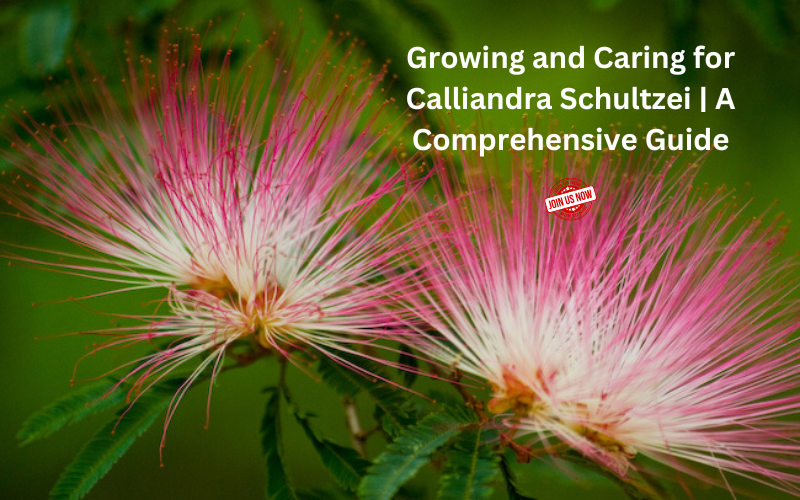
Growing and Caring for Calliandra Schultzei | A Comprehensive Guide
Introduction:
Calliandra schultzei is a beautiful flowering plant that belongs to the pea family Fabaceae. The plant is native to Central America and is commonly found in Mexico, Honduras, and Nicaragua. It is a relatively small tree that grows up to 15 feet in height and is popularly grown as an ornamental plant in gardens and parks.
The Calliandra schultzei plant is known for its beautiful, showy flowers that bloom in bright red or pink colors. The plant has a long flowering period, which extends from spring to fall, making it an attractive addition to any garden or landscape.
If you're interested in growing Calliandra schultzei, this comprehensive guide will provide you with all the information you need to grow a healthy, thriving plant.
Growing Requirements:
-
Climate: Calliandra schultzei is a tropical plant and thrives in warm, humid climates. The plant prefers temperatures between 70°F and 85°F and can tolerate temperatures as low as 50°F. It is best grown in USDA hardiness zones 9 to 11.
-
Light: The plant requires full sun to partial shade to grow and bloom properly. It is recommended to plant Calliandra schultzei in a location that receives at least 6 hours of direct sunlight per day.
-
Soil: The plant prefers well-draining soil that is rich in organic matter. The soil should be slightly acidic with a pH range of 5.5 to 6.5. If the soil is too heavy, it is recommended to add compost or sand to improve drainage.
-
Water: Calliandra schultzei requires regular watering to grow and bloom properly. The soil should be kept moist, but not waterlogged. During the summer months, it is recommended to water the plant twice a week, while in winter, watering should be reduced to once a week.
Propagation:
Calliandra schultzei can be propagated by seeds or stem cuttings. Here are the steps to propagate Calliandra schultzei by stem cuttings:
-
Select a healthy stem from the mother plant that is approximately 4 to 6 inches in length.
-
Cut the stem at a 45-degree angle using a sharp, clean pair of scissors or pruning shears.
-
Remove the leaves from the bottom two-thirds of the stem.
-
Dip the cut end of the stem into rooting hormone powder.
-
Plant the stem in a well-draining potting mix.
-
Water the cutting thoroughly and place it in a warm, bright location with indirect sunlight.
-
The cutting should root within 4 to 6 weeks.
-
After the cutting has rooted, transplant it to a larger pot or into the ground.
Pruning:
Calliandra schultzei requires regular pruning to maintain its shape and promote healthy growth. Here are some tips for pruning Calliandra schultzei:
-
Prune the plant in late winter or early spring before new growth begins.
-
Remove any dead, damaged, or diseased branches.
-
Cut back any branches that have become too long or leggy.
-
Remove any suckers or shoots that are growing from the base of the plant.
-
Shape the plant by removing any branches that are growing in the wrong direction.
Fertilization:
Calliandra schultzei requires regular fertilization to promote healthy growth and blooming. Here are some tips for fertilizing Calliandra schultzei:
-
Fertilize the plant every 2 to 3 months during the growing season.
-
Use a balanced fertilizer that is high in phosphorus, such as a 10-10-10 or 12-12 -12 fertilizer.
-
Apply the fertilizer according to the manufacturer's instructions.
-
Water the plant after fertilizing to help distribute the fertilizer evenly.
Pests and Diseases:
Calliandra schultzei is generally a healthy and disease-resistant plant. However, it can be susceptible to some pests and diseases, including:
-
Spider mites: These tiny pests can cause discoloration and distortion of the leaves. They can be controlled by washing the plant with a strong stream of water or by using an insecticidal soap.
-
Whiteflies: These pests can cause yellowing of the leaves and the production of sticky honeydew. They can be controlled by using an insecticidal soap or neem oil.
-
Leaf spot: This fungal disease can cause brown or black spots on the leaves. It can be controlled by removing the infected leaves and improving air circulation around the plant.
-
Root rot: This fungal disease can be caused by overwatering or poor drainage. It can be prevented by ensuring the soil is well-draining and not waterlogged.
Conclusion:
Calliandra schultzei is a beautiful flowering plant that is relatively easy to grow and maintain. By following the growing requirements outlined in this guide, you can successfully grow a healthy, thriving Calliandra schultzei plant in your garden or landscape. Remember to regularly prune, fertilize, and water your plant to ensure it continues to bloom and thrive for years to come.

Leave a comment